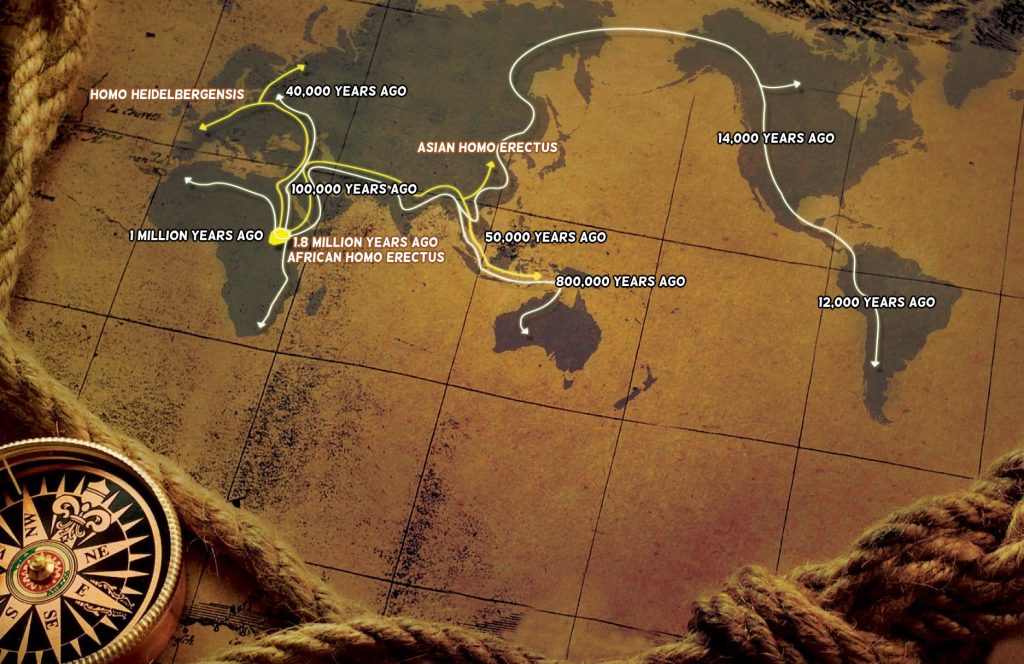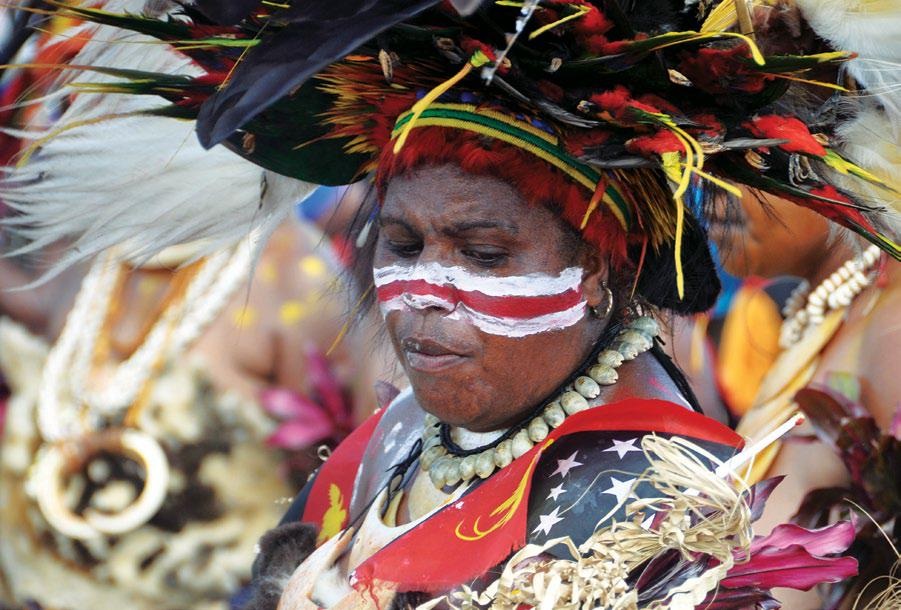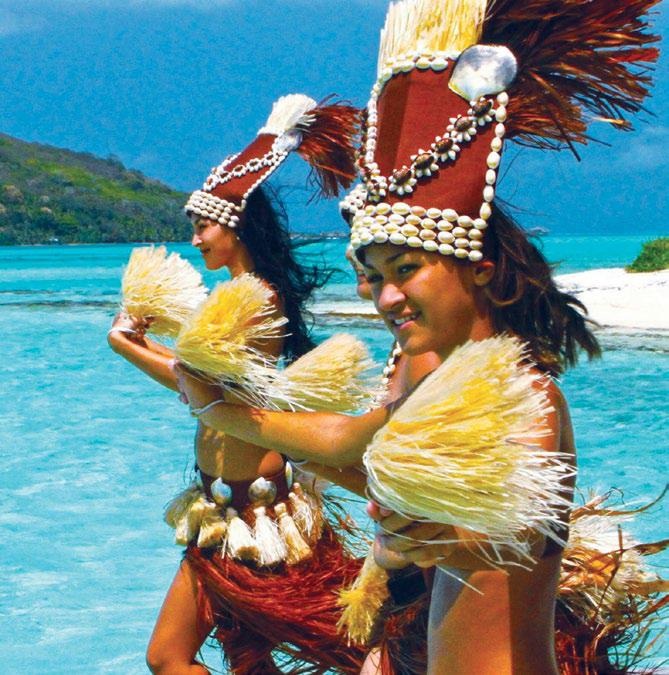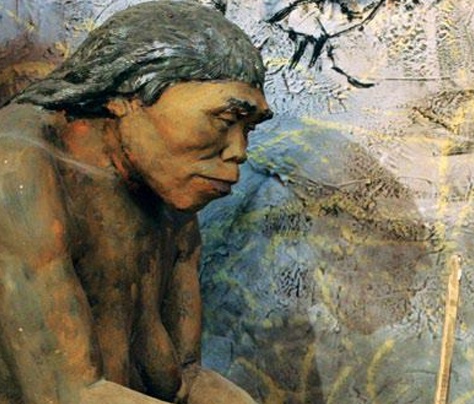In collaboration with HIGH Life: Living the Good Life, VOICE OF ASIA is proud to present timeless articles from the archives, reproduced digitally for your reading pleasure. Originally published in HIGH Life in 2015, we present this story on The Greatest Adventure Ever Lived, of humanity’s journey from the “Cradle of Mankind”, to all over the world.
Somewhere in Kenya in East Africa, there is the “Cradle of Mankind”, the place where the earliest human beings were first born. There were not many of them then, and they faced threats from a hostile environment including predators that wanted to make a meal of them. Yet today, all those carnivorous beasts such as the ferocious sabre-tooth cat are gone, but human beings are still here – six billion strong and spread out across the world, the most dominant species of all time.
When our ancestors left their African homeland tens of thousands of years ago, they travelled across continental shelves, mountains, deserts, land bridges; faced
and overcame challenge after challenge – deadly animals, treacherous weather, and even inhospitable habitat. Then, they created settlements, formed cultures and societies, developed languages, and started the process for the creation of the world as we know it today.
Without those pioneers, those first explorers, our world would definitely have been very different. There is no doubt about it, that adventurous spirit – the desire to explore the unknown, to go where no one has gone before – is part of human nature, thanks to our ancestors from so long ago, who embarked on the greatest and most legendary adventure ever lived.
Out of Africa
From the time the primordial soup started creating the earliest life forms four billion years ago and up to the dawn of the earliest human beings, the world has seen some of the largest, strongest and more ferocious animals lay claim to be the dominant species. Yet, today, it is the human race that is left standing… all others – the dinosaurs, the mastodons, the woolly mammoths, the sabre-tooth cats – have become extinct.
We survived because we evolved, thanks to the combination of diet and proper early care. Our ancestors used to live in trees, safe from ground predators and so were able to live longer and develop better. They learnt to cook and so were able to better digest their food, contributing to the growth of brain mass and greater intelligence.

Similarly, the map represents shorelines and continents as we know them today; the ice age, as well as the shifting of tectonic plates, mean that the shape of the land mass thousands of years ago will have looked distinctly different.
Go West (and North, and South, and East)
Biologists and anthropologists have no doubt that we are all descended from the first human beings who made their appearance in what is modern day Africa. While environmental factors shaped our skin, build, and hair colour, each and every one of us share the same genetic marker that points to our common ancestry.
When our ancestors came out of Africa, they weren’t the only hominids in the world. There were others, such as the Homo Erectus (Upright Man) in Asia and the Neanderthals in Europe. However, by 39,000 years ago, these ‘cousins’ of the human race had become extinct, leaving Homo Sapiens as the only species of the genus homo in the world.
To become dominant, our ancestors had to leave Africa, and brave the elements, the terrain, wild animals, even aggression from other hominids. These very first pioneers set the stage for the world as we know it today.
But why did the first human beings leave the African savannah to go to other parts of the world? The most obvious answer is that they did so to find new sources of food. But that is only part of the story. By nature, we are a very curious and adventurous species, which has been
shown throughout history, in the form of great scientists, inventors, and explorers. We have a thirst to know more, and it is no surprise that our ancestors shared the same trait, since it came from them.
They left the savannahs of East Africa, and headed across all parts of the continent. Those who ventured west and south found further travel cut off by vast oceans, and so they stayed there, forming communities that would later become the various tribes of Africa.
But others pressed on north, and at what is today the Bad-el-Mandeb Strait between Africa and the Arab Peninsula, they found their crossing point. Of course today it is impossible to make that crossing by foot, but 60,000 or so years ago, the waters were shallower (approximately 230 feet less deep than today), making it easier to travel by foot or even by raft.
In the Fertile Crescent
The migration to the Arab Peninsula saw the eventual development of the Semitic people, and also gave our ancestors land access to Europe, India and East Asia, creating the conditions for human migration to the rest of the world. Agriculture also started in the Middle East, when one of our great (to the power of near infinity) grandmothers discovered that by scattering seed into the soil, she could grow plants for food. It was a life-changing event, as human beings could now stay in one area without having to wander in the search for sustenance.




Thus began the first permanent settlements. Over time they expanded, as life expectancy increased thanks to greater security and easier access to nutrition. They became villages, then towns and finally cities. As communities began recognising hierarchies and leaders, and organising themselves in a more formal structure of society, so emerged the concept of government.
It was during this time that organised religion started – a milestone in the development of society, because it changed the way rulers assumed and kept power. Whereas in the past, the concept of ‘might makes right’ meant that the community was ruled by the strongest (who could be overthrown by someone stronger), the mandate of the rulers of these new city-states came from the gods. In these theocracies, the ruler’s position was almost unassailable because he was the conduit through which the deities spoke.
And so it was that the ancient empires of the Middle East came to be – the Akkadian, the Mesopotamian, and the Egyptian
– each one ruled by their own version of a king-priest. It was a time of great monuments such as the legendary Hanging
Gardens of Babylon, and the magnificent Pyramids of Egypt – vast tombs for the Pharaohs, the God-Kings of Egypt,
which took decades to construct; a testament to ancient engineering techniques.
And it was around this time, in what is present-day Saudi Arabia, that a family or maybe even a group of people developed the concept of monotheism – the idea that there was only one god. While details of their travels are not known, we can assume that they crossed the Saudi desert to Iraq, and from there passed over the Euphrates River to what is present day Jordan. The leader of this expedition was the inspiration for Abraham – the father of the Abrahamic religions of Judaism, Christianity and Islam.
A Passage to India
However, long before the advent of monotheism or even the earliest Semitic city states, there were those who went northwards to present day Europe, while others headed east to Asia. The second group eventually settled in the Indus Valley which is encompassed in modern day India and Pakistan.
The rich fertile conditions of the land made it an ideal place to settle and, soon, just as in the Middle East, early human settlers started to form cities, societies and religions. The people of the Indus Valley Civilisation were also unique for being among the first to use measures and mathematics, as archaeologists have found scales dating back to the period.
In addition to weights and measures, the ruins of the Indus Valley Civilisation show that they had knowledge of urban planning and sanitation systems, including sewers and drains, at a time when such concepts were unknown or poorly executed by others.
Over time, the Indus Valley civilisation collapsed. However, its people – the Indo-Aryans – migrated to the north-west of present day India, and started anew. This was the start of the Vedic civilisation in India, when classics of Indian literature such as the Vedas and the Upanishads were written. Hinduism was also developed and over time, Buddhism was adapted from it.
While the Indo-Aryan people populated the north of India, there was another group which went south, hugging the sub-continent’s west coastline. Eventually, they settled in the southern part of the region, becoming the ancestors of the Dravidian-speaking people like the Tamils, the Malayalis and the Telugus.
Some of the more adventurous Dravidian ancestors went further southeast, and travelled across the oceans to what is present day Southeast Asia and Australia. In fact, mitochondrial DNA testing reveals genetic similarities between those descended from southern Indians and indigenous Australians, thus pointing to a shared maternal ancestor.
Journey to the East
Back to the Middle East and tens of thousands of years ago, just as one group headed east to India, another group went north. Europe, however, was out of bounds – not only was the cold weather inhospitable, but the Neanderthals living there were hostile. So, these early humans went to what is present day Central Asia – becoming over time the Kazakhs, Uzbeks, Turkmen and Kyrgyz.
Some went further east, crossing into China. Interestingly, it also appears that aside from migration from the west, China was also populated by those migrating from the southwest. In fact, DNA testing has shown that some in India share the same genes as some people in China, while others share genetic characteristics with Central Asians.
While it may be common to describe the Chinese as a single, homogenous group, these findings indicate a more diverse background than is commonly known or accepted. In fact, the Chinese also share a common ancestry with two other unlikely groups of people – the Native Americans and the Inuit (Eskimos) of North America.
This came about as a result of the crossing of the great Bearing Land Bridge tens of thousands of years ago, when some of the early humans in China braved the journey to Siberia and then east to Alaska. In fact, one can see similarities in appearance between an Inuit and certain groups in China, while the Mongolian yurt and the Native American wigwam are another indicator of a common heritage.
Europe Calling
The cold spell eventually receded, leaving the path clear for the early humans to cross into Europe. There they had to contend with the Neanderthals who were already present. It was not easy going as the competition for resources such as food and shelter meant that the two sides often clashed, and over time, the Neanderthals were wiped out.
The cause has been debated, but is generally agreed that factors such as interbreeding and prehistoric genocide by those first humans resulted in their demise. It was humans who outlasted them all, differentiated by their adventurous spirit and sense of exploration and legacy.
Besides the Neanderthals, the early settlers in Europe also had to deal with the cold weather. It was during this time that humans developed sewing, using stones as primitive needles and stitching together animal skins and furs to keep themselves warm. Europe, incidentally, is also where the first cave paintings can be found, showing that the concept of art as a medium of communication is one that has been with us for eons.
The End of the Beginning
Finally, human beings were in all parts of the world. As time went by, features changed owing to weather conditions. For example, in northern Europe, where the sun was at a premium during winter, the lack of sunlight resulted in the development of lighter colour skin and hair, while in blazing hot Africa and the Middle East, darker, swarthier skin tone was the order of the day in order to protect the people from the heat. However, there is no doubt that everyone came from the same origins.




The human migration story is a real life epic, a story of people driven to brave the unknown, and by doing so wrote the story for the survival and dominance of humankind. So many things could have gone wrong, especially during those crucial years after the start of the first Ice Age when only 10,000 human beings remained in the world.
But we survived. We survived because we developed a variety of skills including tool making, fire making, and others that enabled us to overcome whatever limitations we had and adversities we faced. And remarkably today, tens of thousands of years later, we are still here, whereas those threats to our ancestors – the sabre-tooth cat, the mastodon, prehistoric birds and even killer marsupials – are all extinct.
And we will continue to be here, because if there is one thing that history has proven, it is that human beings are survivors. But more than just survivors, we are winners driven by that sense of adventure, the desire to expand our horizons, and seek out new worlds. There may not be much land that has yet to be explored, but further exploring underwater and space has been considered, colonisation of the moon and even other planets have been discussed. Perhaps it seems fantastical, but that’s what being human is about – the ability to imagine an adventure beyond our limits, and through force of will, turn it into reality.



